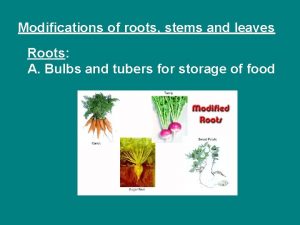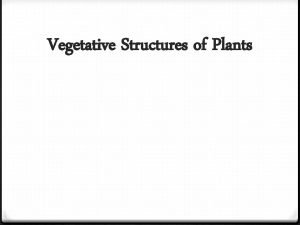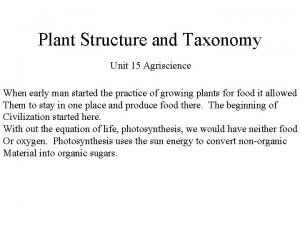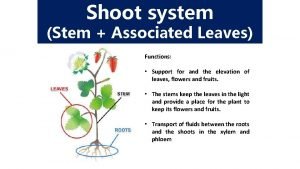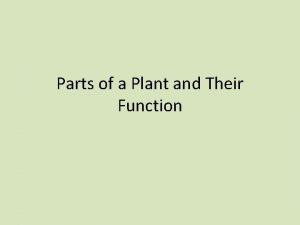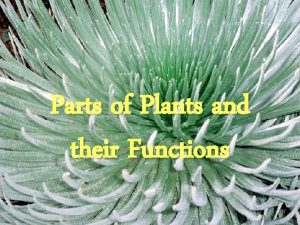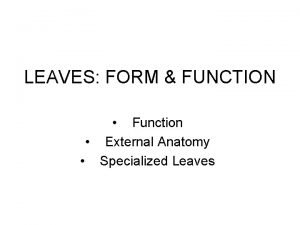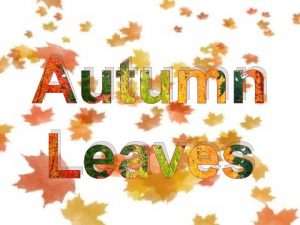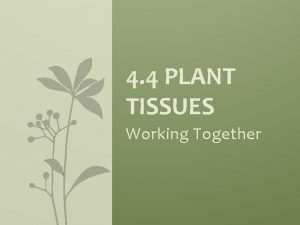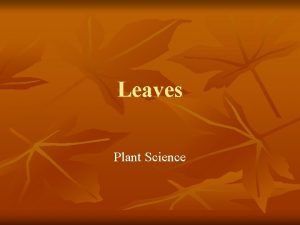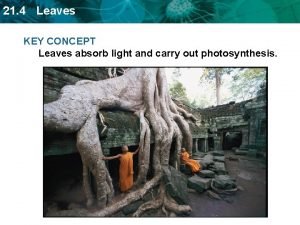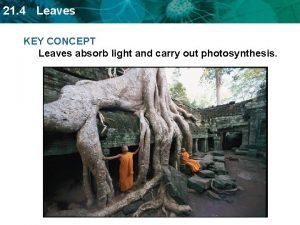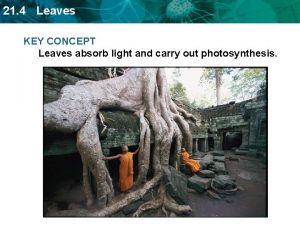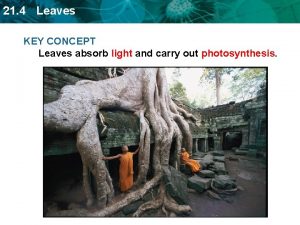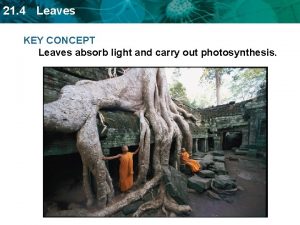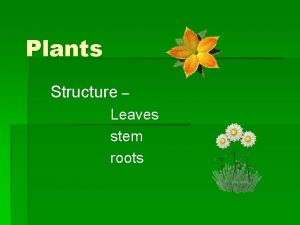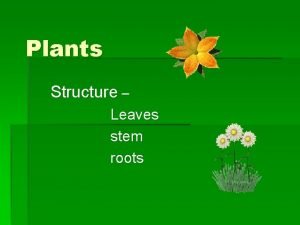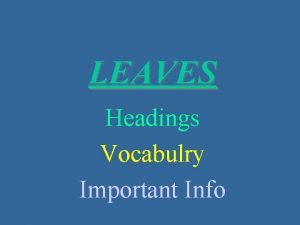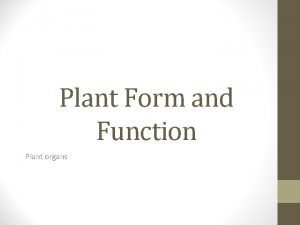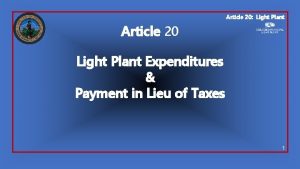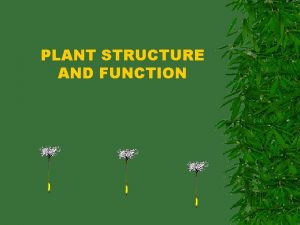PLANT STRUCTURES LEAVES FUNCTION OF LEAVES Convert light




















- Slides: 20

PLANT STRUCTURES: LEAVES

FUNCTION OF LEAVES • Convert light energy into chemical energy for the plant to use (photosynthesis) • Leaves are thin and flat allowing for more surface area to absorb light energy • Epidermis is thin allowing for more light to be absorbed • Stomata on the leaves allow for gas to be exchanged easily for the process of photosynthesis • Leaf veins provide the minerals and water necessary to carry out photosynthesis

INTERNAL FEATURES Leaf Blade Layers: § Epidermis-outer layer of tissues § Cuticle: waxy protective layer on outside of epidermis. Prevents water loss on leaves, green stems, and fruits. § Leaf hairs: part of the epidermis § Palisade-tightly packed layer of parenchyma tissues filled with chloroplasts for photosynthesis § Chloroplasts: contain chlorophyll and begins the transformation of that energy into sugars

INTERNAL FEATURES Layers Cont. § Vascular bundle: xylem (transports water) and phloem (transports nutrients) tissues (leaf veins) § Spongy mesophyll: layer of parenchyma tissues that help move oxygen, carbon dioxide, and water vapor § Stomata: Openings in leaves that allow for gas exchange § Guard Cells: kidney-shaped cells that open and close the stomata

EXTERNAL FEATURES Parts of the Leaf on the Outside Include: § Leaf Blade: flattened part of the leaf § Petiole: Leaf stalk § Stipules: Leaf-like appendage at the base of leaf


LEAF TYPES Monocot § One cotyledon § Parallel venation: veins run in parallel lines Dicot § Two cotyledons § Net-veined: veins branch from main rib and subdivide (pinnate/palmate)

ADAPTATIONS FOR ENVIRONMENT • Plants that live in the water • Have stomata on the top of the leaf since this is the part exposed to the air • Conifers • Needles have adaptations that help them survive during the winter which allows trees to keep their leaves throughout the year • Deciduous • Shed leaves during the dry season to save the tree due to lack of water

TRANSPIRATION • 99% of the water that a plant absorbs is lost through evaporation. This process is called transpiration: loss of water vapor from plant parts such as the stem and leaves • The leaves have a cuticle to reduce this water loss by having a waxy covering • Stomata are the main reason most water is lost and too much water loss can cause wilting of the plant • Factors that affect transpiration • • Higher air temperatures • Light • Wind and dry air Benefits: allows for water movement, cools the plant, moves minerals through plant

GUTTATION • Many leaves have hydathodes, or openings at the tip of leaf veins. These openings can release water in liquid form (guttation) • This process typically happens at night when the stomata are closed • Sometimes guttation is misunderstood to be dew on plants in the morning

LEAF ARRANGEMENTS § Alternate: staggered arrangement along stem § Example: willow tree

LEAF ARRANGEMENTS § Opposite: Pair of leaves arranged across from each other on a stem § Example: maple tree

LEAF ARRANGEMENTS § Whorled: arranged in a ring § Example: Blackboard tree

LEAF ARRANGEMENT § Rosette: spiral cluster of leaves arranged at the base § Example: dandelion

LEAFLET ARRANGEMENT § Simple: leaf blade one continuous unit § Example: cherry, maple, elm

LEAFLET ARRANGEMENT § Compound: Several leaflets from same petiole § Palmately compound: leaflets radiate from one central point § Example: Ohio Buckeye § Double Pinnately Compound: double set of compound leaflets § Example: poison ivy

LEAF SHAPE

LEAF BASE SHAPE

MODIFIED LEAVES • Spines • Hard and pointed leaves found on desert plants used to help keep animals from eating the plant • Bracts • A leaf that is associated with a flower but not part of the flower itself

MODIFIED LEAVES • Tendrils • A leaf of a vine that is able to hold on to and attach to other objects • Carnivorous Plants • Leaves are adapted to catch insects by having hairs or sticky parts that cause the insect to stick or not be able to leave
 Leaf cell types
Leaf cell types Light light light chapter 23
Light light light chapter 23 Light light light chapter 22
Light light light chapter 22 Light light light chapter 22
Light light light chapter 22 Homologous structures definition
Homologous structures definition The leaves of utricularia plant are modified into
The leaves of utricularia plant are modified into Study of modification of root stem and leaf
Study of modification of root stem and leaf Part of flower
Part of flower Unit 15 plant structures and taxonomy
Unit 15 plant structures and taxonomy Wood light frame
Wood light frame Intraspecific hybridization
Intraspecific hybridization Taichum
Taichum Plant introduction in plant breeding
Plant introduction in plant breeding Tronsmo plant pathology and plant diseases download
Tronsmo plant pathology and plant diseases download Tronsmo plant pathology and plant diseases download
Tronsmo plant pathology and plant diseases download Tronsmo plant pathology and plant diseases download
Tronsmo plant pathology and plant diseases download Stem shoot
Stem shoot Parts of leaves and its function
Parts of leaves and its function Function of plants
Function of plants Primary active transport and secondary active transport
Primary active transport and secondary active transport Othello put out the light
Othello put out the light






